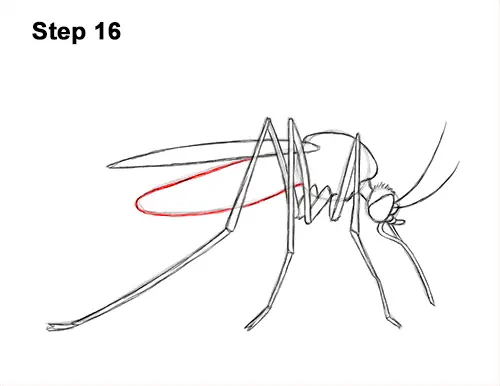
Step 15: Darken the initial circle guide to create the shape of the thorax. Make the sides of the mosquito's thorax longer than the initial circle. And don't overlap the legs as you darken the lines.

Step 16: Darken the long shape on the left to create the mosquito's abdomen. You can make this shape rounder and thicker to indicate a bigger, post-meal abdomen.

Step 17: Draw the mosquito's legs on the other side of the body using long lines. The front leg on the other side should be below the neck. Add a few short lines above thorax for the tops of the legs. Only the tops of the folded legs from the other side should be visibly. Add the mosquito's middle leg on the other side below the thorax.

Step 18: Draw a small, triangular shape on top of the thorax for the folded joint of the last leg on the other side. Add the bottom half of the mosquito's final leg below the abdomen. The leg should slope to the left. Sketch lightly at first. Darken the line only when you get the shape right.

Step 19: For a cleaner look, erase as much as you can of the initial guide lines. Don't worry about erasing all of the guides. It's okay to leave some behind. Re-draw any final sketch lines you may have accidentally erased.

Final Step: Add some shading to your mosquito drawing for extra detail. Use a dark value for the eye. Use a lighter value at the top of the eye for highlight. Use a series of short strokes on the head for tiny hairs. Add some short strokes on the antennae too. Use a medium value to shade most of the mosquito's body. Use a slightly darker value as you shade the areas of the legs that are near the joints. Vary the pressure on your pencil to get different degrees of tonal value. For a more detailed guide on how to shade, check out this tutorial: How to shade.
Shade the mosquito's wing using a light value. Draw a few curved lines inside the shape for the veins. Use a series of tiny, curved lines for the hair that covers the thorax. Make the top area lighter for highlight. It's a good idea to use reference as you draw for a more accurate depiction of a mosquito. Shading can be time-consuming, so be patient and take breaks.
Use a light value to shade the mosquito's abdomen. Because you're using a light value, it's okay if you overlap the legs a bit. Using a medium value, add a series of thick stripes along the abdomen.
Add a cast shadow underneath. This helps to ground the mosquito so it doesn't appear to be floating. Don't forget to pause the video after each step to draw at your own pace. You can add a bit of shadow to the underside of the mosquito's body using a darker value to give the figure more dimension and volume.
Thanks for visiting! Subscribe to the How2DrawAnimals YouTube Channel for a new tutorial every week.
To learn how to draw popular cartoon characters, visit EasyDrawingTutorials.com.
RELATED TUTORIALS
 |
 |
 |







